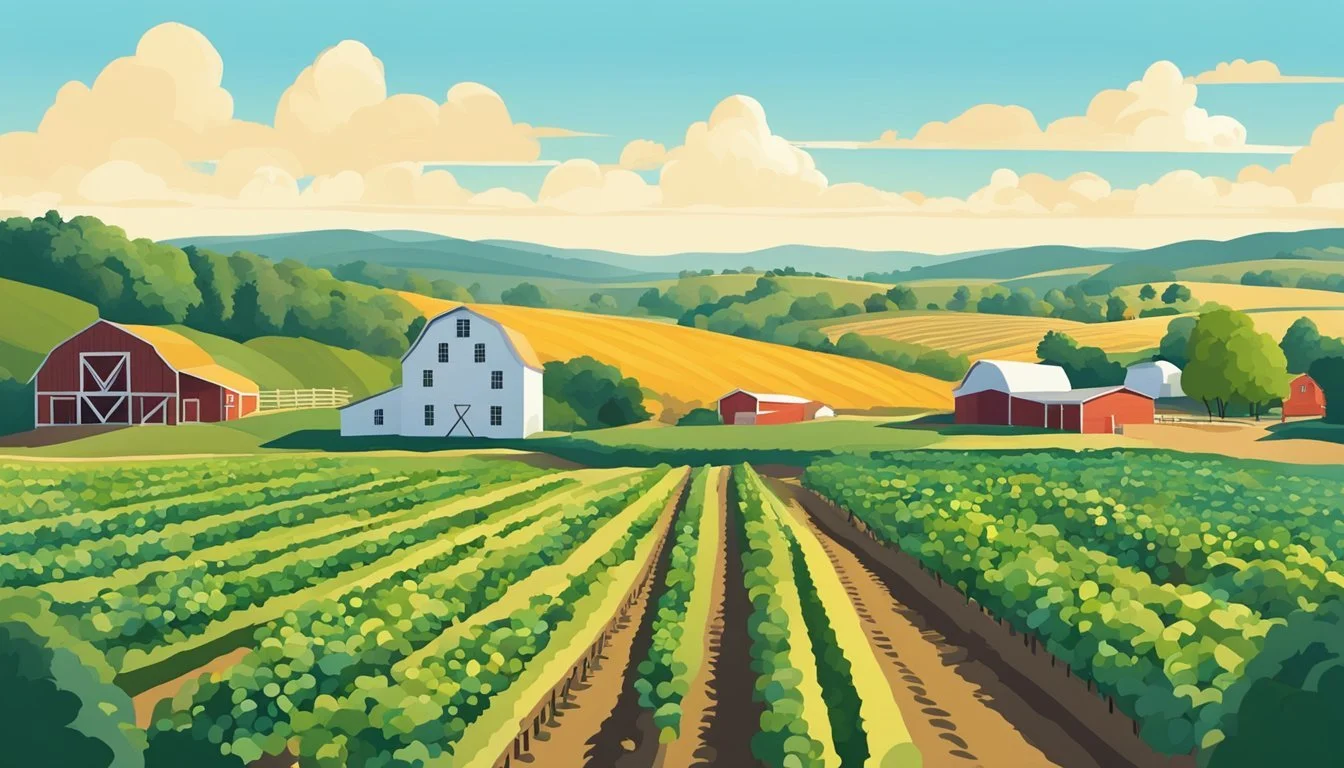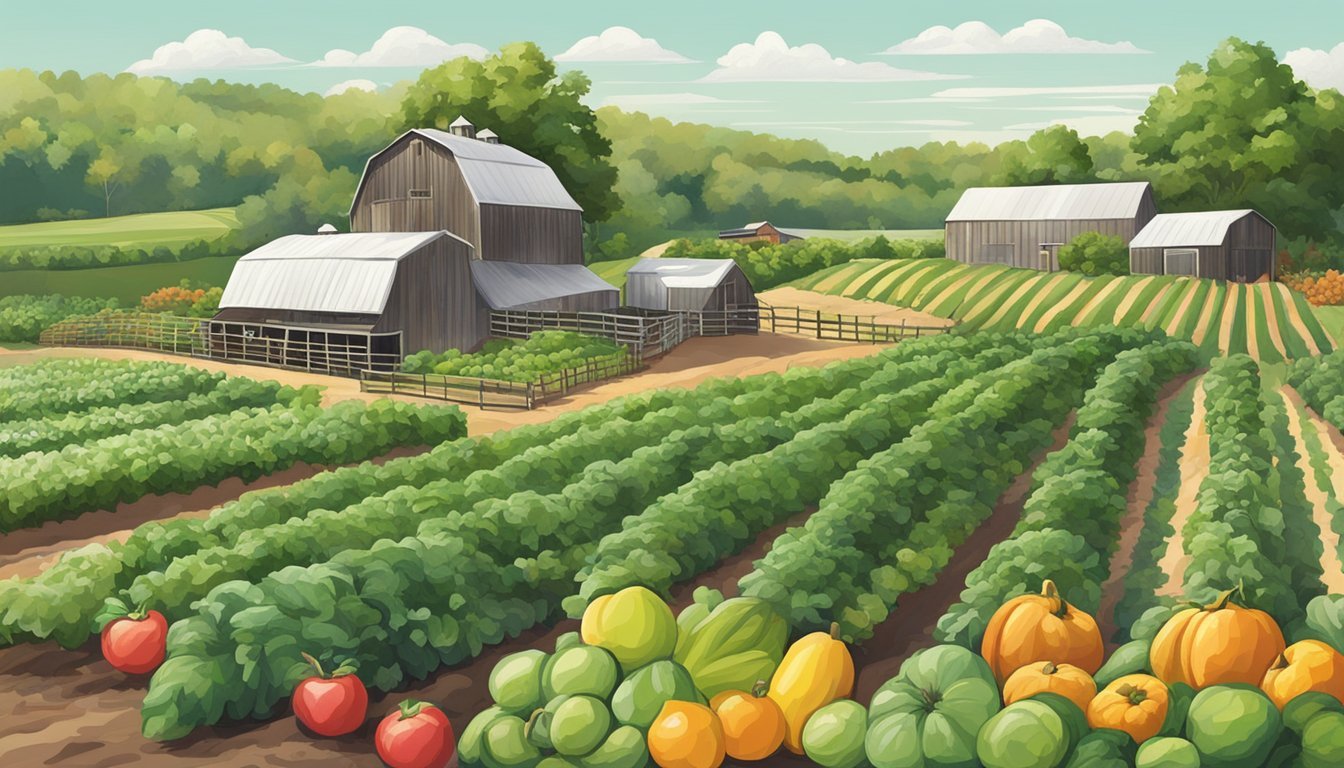Ohio Seasonal Fruit & Veg Guide
Your Quarterly Eating Plan
Ohio's diverse climate and fertile soil foster a rich agricultural landscape, leading to a variety of fruits and vegetables grown throughout the year. Embracing farm to table practices not only supports the local economy but also provides access to the freshest, most nutritious produce. Seasonal eating in this state reflects the rhythmic change of the seasons, offering a constantly evolving palate of flavors and nutrients influenced by Ohio's distinct weather patterns.
A comprehensive guide to Ohio's seasonal produce enables consumers and chefs alike to make informed decisions about the fruits and vegetables they purchase and consume. By aligning their menus and shopping lists with the natural harvesting cycle, they ensure peak freshness and flavor, while also minimizing their environmental footprint. This guide serves as an essential tool for anyone interested in exploring the rich bounty of Ohio's farms throughout the changing seasons.
Understanding the seasonal availability of produce ensures that individuals experience the full taste and nutritional benefits that come from eating fresh, locally-sourced food. It also provides insights into Ohio's agricultural calendar, such as when to expect the sweetest corn (how long does corn last?), the juiciest tomatoes, or the crispest apples (how long do apples last?). By following the natural harvest periods and storage techniques, Ohioans can enjoy a year-round supply of fresh produce, keeping the farm to table movement alive and thriving.
What’s in Season in Ohio Right Now?
Ohio's Farming Landscape
Ohio stands out for its rich agricultural tradition, with farming playing a pivotal role in both its economy and cultural heritage. The state's diverse climate and fertile soil allow for a variety of crops, making it a prime example of productive farmland.
State Farmland and Agriculture
Ohio boasts over 14 million acres of farmland, with agriculture constituting a significant segment of its economy. The state's farmers specialize in a wide array of products, including soybeans, (how long do soybeans last?) corn, and dairy, as well as a variety of fruits and vegetables. Ohio's varying seasons and advanced farming techniques ensure a year-round availability of fresh produce to support the farm-to-table movement.
Ohio Farm Bureau and Facilities
The Ohio Farm Bureau, founded in 1919, is instrumental in supporting Ohio's farming community. With a strong focus on modern agriculture practices, the Farm Bureau offers various services, including educational events and marketing assistance to Ohio farmers. State-of-the-art storage facilities and innovative farming methods extend the availability of Ohio's produce well beyond traditional harvesting periods. This commitment to agriculture helps maintain a sustainable and strong local food system.
Seasonal Guide to Fruits and Vegetables
In Ohio, the availability of fruits and vegetables changes with the seasons. Each part of the year offers a unique range of produce that reflects the state’s agricultural cycle.
Winter Harvest
During the cold months, Ohio's harvest includes storage crops and hearty vegetables. Root vegetables and some fruits are still available thanks to modern storage techniques.
Fruits: Apples, Pears
Vegetables: Beets, Cabbage, Carrots (how long do carrots last?), Onions, Potatoes, Sweet potatoes, Winter squash
Spring Selections
Spring in Ohio sees a resurgence of fresh produce. As the ground thaws, early season crops begin to appear in farmers' markets.
Fruits: Rhubarb, Strawberries (late spring)
Vegetables: Asparagus (how long does asparagus last?), Lettuce, Radishes, Spinach
Summer Variety
Summer brings a wealth of variety. Warm weather and longer days are perfect for a broad array of fruits and vegetables to thrive.
Fruits: Blueberries, Cherries, Peaches, Raspberries, Watermelon
Vegetables: Corn, Cucumbers (how long do cucumbers last?), Green beans, Peppers, Tomatoes, Zucchini (What wine goes well with zucchini?)
Fall Favorites
Autumn is a time for harvest before the first frost. Ohio offers an abundance of fruits and vegetables as the season changes.
Fruits: Apples (new varieties), Grapes, Pears, Pumpkins
Vegetables: Broccoli, Brussels sprouts (how long do brussels sprouts last?), Cauliflower, Leeks, Turnips
Monthly Availability of Produce
Ohio’s climate and soils support a rich variety of fruits and vegetables, with distinct tastes and freshness that change with the calendar. The following guide provides an overview of the availability of produce on a monthly basis, ensuring consumers can enjoy Ohio’s farm-to-table offerings at their peak.
What's in Season in February
Vegetables: Cabbage, Leeks, Mushrooms, Onions, Potatoes, Sweet Potatoes, Winter Squash
Fruit: Apples (stored from fall)
Fresh Picks for May
Vegetables: Asparagus, Radishes, Rhubarb, Spinach
Fruit: Strawberries (late May)
June's Bountiful Crops
Vegetables: Broccoli, Cucumbers, Lettuce, Peas, Radishes, Zucchini
Fruit: Cherries, Strawberries (early June)
Harvest Calendar for July
Vegetables: Green Beans, Sweet Corn, Tomatoes, Zucchini
Fruit: Blueberries, Peaches, Raspberries
August's Peak Season Produce
Vegetables: Bell Peppers, Eggplant, Sweet Corn, Tomatoes
Fruit: Apples (early varieties), Blackberries, Grapes, Melons, Peaches
September's Rich Harvest
Vegetables: Cauliflower, Pumpkins, Sweet Corn, Tomatoes
Fruit: Apples (late varieties), Pears
October and November Endings
October Vegetables: Brussels Sprouts, Cabbage, Kale, Pumpkins
October Fruit: Apples, Grapes
November Vegetables: Beets, Carrots, Onions, Potatoes
November Fruit: Cranberries
December's Limited Offerings
Vegetables: Beets, Carrots, Onions, Potatoes, Winter Squash
Fruit: Apples (stored)
Growing Conditions and Harvest Periods
Ohio offers a diverse climate for agricultural production, which leads to a rich variety of fruits and vegetables throughout the year. The state's growing conditions and harvest periods are shaped by seasonal changes, requiring different farming techniques and storage methods to ensure a year-round supply.
Late Winter and Early Spring Growth
In late winter leading into early spring, Ohio's cooler temperatures and gradually increasing daylight promote the growth of cool-season crops. Farmers may plant vegetables such as spinach, kale, and a variety of lettuces, which are hardy and can tolerate frost. Initial harvests often begin in April, depending on the weather conditions.
Summer Growing Conditions
With summer comes warm weather and longer days, creating optimal conditions for growing a range of produce. Tomatoes, peppers, corn, and berries thrive in these conditions. Harvest periods for many summer crops peak from June through August. Farmers may use irrigation systems to maintain consistent moisture levels and protect against summer heat stress.
Preparing for Fall Harvest
Fall in Ohio brings cooler temperatures and shorter days, signaling crops like apples, squash, and pumpkins to mature. Harvesting generally starts in September and extends into October. During this period, farmers often prepare their fields for winter by planting cover crops, which protect the soil and replenish nutrients.
Winter Storage and Last Harvests
Many fruits and vegetables can be stored well into the winter months through various storage techniques. Apples, for instance, are kept in controlled atmosphere storage to extend their freshness. Additionally, some late harvests, including root vegetables like potatoes, carrots, and beets, are gathered before the ground freezes, with these crops often benefiting in flavor after a light frost.
Farm-to-Table Crop Categories
The farm-to-table movement in Ohio emphasizes fresh, local produce segregated into seasonal fruit and vegetable categories. Farms focus on providing a variety of crops that are harvested at peak times throughout the year to ensure flavor and nutritional value.
Seasonal Fruit Highlights
In Ohio, fruit production aligns with seasonal conditions. Peaches, for instance, are best from July to September. Local markets also feature fruits like apples in late summer with varieties continuing to appear until late fall.
Strawberries make a brief but delightful appearance in June, where they are celebrated for their fresh, sweet flavor. For those who favor berries, blueberries and blackberries are abundant in mid to late summer.
Vegetable Variety Throughout the Year
Ohio's climate supports a robust variety of vegetables. A farm-to-table approach showcases vegetables at their in-season peaks. Tomatoes, zucchini, and sweet corn are summer staples, often harvested from July through August.
The cooler months bring out the best in certain crops. Kale, spinach, and root vegetables like carrots and potatoes are commonly harvested in the early fall to late spring.
Throughout the year, farm-to-table initiatives emphasize eating vegetables that are in season to support local agriculture and provide the freshest options to consumers.
Sourcing and Buying Local Produce
Sourcing local produce in Ohio connects consumers with the freshest fruits and vegetables while supporting regional farmers. This guide will focus on the specifics of navigating farmers markets and forming connections with local farmers for the best farm-to-table experience.
Navigating Ohio's Farmers Markets
Ohio boasts a rich tapestry of farmers markets that offer a variety of seasonal products. When visiting these markets, shoppers should:
Look for markets in their local area by visiting the Ohio Farm Bureau's website for an updated list.
Keep in mind that availability of produce can vary based on growing conditions and time of year.
Familiarize themselves with peak seasons for different fruits and vegetables to shop efficiently.
Connecting with Local Ohio Farmers
Developing relationships with local Ohio farmers can provide insights into how produce is grown and ensure a supply of fresh, seasonal produce. To forge these connections:
Engage with Community Supported Agriculture (CSA) programs, which allow consumers to buy shares of a farmer's harvest.
Utilize online resources like LocalHarvest to find farmers offering CSAs or selling produce directly to consumers.
Attend local agricultural events and workshops to meet farmers and learn more about Ohio's seasonal offerings.
Key Produce in Ohio
Ohio boasts a diverse array of produce throughout the year, reflecting the state's rich agricultural heritage. From the essential corn crop to a colorful selection of fruits and vegetables, Ohioans enjoy a variety of fresh, local options.
Corn: A Staple Crop
Corn is central to Ohio's agricultural output, especially sweet corn, which typically becomes available in July and lasts through early October. Sweet corn is celebrated in Ohio for its juicy kernels and is a common feature at local markets.
Ohio's Summer Fruit Selection
Ohio's summer months are brightened by the sweetness of peaches and watermelons, with both reaching peak ripeness from July to August. Cantaloupes (how long does cantaloupe last?) also enter the scene mid-summer, offering Ohio residents a juicy, flavorful option during the warm season.
The Variety of Vegetables
The state's fertile soil produces a plethora of vegetables; key players include tomatoes, carrots, and cucumbers, which are commonly harvested from July to September. Leafy greens like kale and chard also thrive, alongside root vegetables such as turnips and beets, spanning across multiple seasons.
Winter Squash and Hardier Picks
As autumn arrives, Ohio transitions to heartier selections like winter squash, pumpkins, and squash varieties, which store well into the colder months. These robust vegetables are often harvested from September to November, intensifying the flavors of Ohio's fall and winter dishes.
Storing and Preserving Ohio Produce
Proper storage and preservation are crucial for extending the shelf life of Ohio's diverse produce. Employing the right techniques ensures that fruits and vegetables retain their nutritional value and freshness until they're ready to be used.
Optimal Storage Techniques
Cool and Dry Storage: Root vegetables like potatoes and onions are best kept in a cool, dry place with good air circulation. They should be stored at temperatures around 45-50°F, away from light, which can cause sprouting and spoilage.
Refrigeration: Leafy greens, such as lettuce and spinach, and a multitude of other vegetables, including carrots and cucumbers, should be stored in the refrigerator. The crisper drawer provides the ideal level of humidity to keep them fresh. Most fruits, like apples and berries, also benefit from refrigeration, where they can last longer.
Ethylene Gas Awareness: Some fruits, such as apples, emit ethylene gas, which can accelerate ripening and subsequently spoilage in nearby ethylene-sensitive vegetables. These fruits should be stored separately to prevent premature decay in other produce.
Long-Term Preservation of Harvest
Canning: This traditional method involves sealing cooked or raw produce in sterile jars to be stored at room temperature. Tomatoes, for instance, can be canned as sauces, salsas, or whole fruit. Canned goods can last for years when properly prepared and stored.
Freezing: Freezing is effective for many fruits and vegetables but requires blanching (a quick dip in boiling water) for most vegetables beforehand to stop enzyme actions that can cause loss of flavor and color. Berries can be frozen whole on a tray and then transferred to airtight containers for long-term storage.
Drying: Dehydration is ideal for preserving Ohio's apples and herbs. Dried at the right temperature, these products can maintain a high quality of taste and nutrition for months. They should be stored in airtight containers in a dark, cool place to maximize their shelf life.
Supporting Ohio's Farm Economy
Ohio's agricultural sector is a cornerstone of its economy, contributing significantly through local initiatives and sustainable practices.
The Impact of Agriculture on Ohio's Economy
Agriculture is not just a traditional activity in Ohio; it's a vital economic engine. The farms across the state play a critical role in stimulating local economies, and the farm-to-table movement enhances this impact. Ohio’s agricultural industry extends beyond the fields, influencing related sectors such as transportation, retail, and equipment manufacturing.
Economic Contributions:
Directly employs a substantial portion of the state's workforce
Generates billions annually in economic activity
Supports a wide range of ancillary industries
Sustainability and Local Initiatives
Ohio's commitment to sustainability is evident in its support for local farms. Local initiatives aim to preserve Ohio’s agricultural legacy while ensuring food systems remain robust and sustainable.
Reduced transportation distances lower carbon footprints
Conservation of local farmland through community-supported agriculture
Emphasis on organic and environmentally friendly farming techniques
Local initiatives not only foster sustainable practices but also encourage Ohioans to invest in their communities, enhancing the state's economic and environmental health. These efforts position Ohio's agriculture for long-term resilience.











